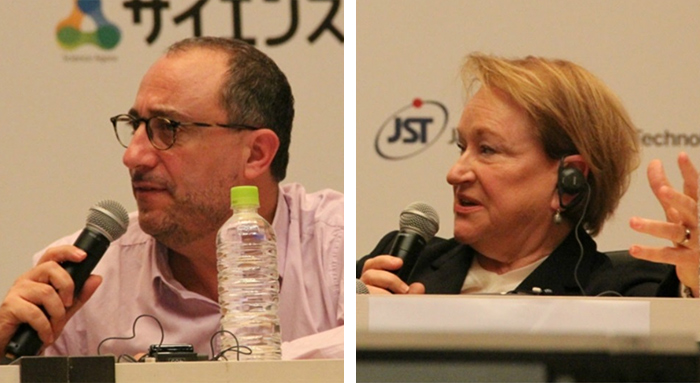前半
Part1
後半
Part2
本キーノートセッションでは、芸術と科学の両分野をまたいで活躍する専門家やアーティストの方々に、ヨーロッパと日本からお集まりいただき、近い将来、コンピューターやロボットの進化が、私たち人間の生活、なかでもクリエイティビティという面において、どのような影響や挑戦をもたらすのか、それぞれの視点からざっくばらんにトークを繰り広げていただきました。芸術、科学、技術、クリエイティビティの関係性、分野を超えた交流の仕方やあり方などについて、議論が交わされました。
The aim of the keynote was to bring together leading figures from Europe and Japan that are involved in bridging gaps between the arts and sciences. Panelists sought to explore how the power of computers and robots might challenge human activities in the near future, particularly as they relate to human creativity. During the session, the participants sought to address some key questions around the relationship between the arts, science, technology and creativity.

セッションは、モデレーターであるフランス国立科学研究センターの北アジア地域事務所所長のフィリップ・コドニェ氏によるトークから始まりました。「実は、芸術家は昔から作品作りに科学を多用してきました。この傾向は現代にももちろん受け継がれています。現代のアーティストたちはコンピューターを使ってイメージを作り上げ、新しい発想を練り、新たな領域を探求しているのです」
次に、メディアアートに関する世界的なイベントを主催するオーストリアのアルスエレクトロニカからディレクターのゲルフリート・ストッカー氏が登壇し、1979年よりスタートしたアルスエレクトロニカの活動について触れた後、「芸術的な視点を持つことで、より優れた新製品を開発することが可能になります。例えば、2016年にスタートした、芸術、科学、イノベーションのシナジーを称える欧州委員会のSTARTS賞で優勝したアーティストたちは、3Dプリント、レーザープリント、磁場を用いて、衣服をデザインしています」とコメントしました。
The session began with the moderator, Philippe Codognet (CNRS) talking of how artists in the past often used science and this tradition continues with modern artists using computers to generate images and explore new areas. This is being further extended as computers become an extension of our body.
Gerfried STOCKER (Director, ARS Electronica, Linz, Austria) introduced ARS Electronica's efforts. He talked of how an artistic viewpoint can inform new products, and gave numerous examples, including how the 2016 STARTS prizewinner had used 3D printing, laser printing, and the influence of magnetic fields to create clothing.

フランス国立音響音楽研究所(IRCAM) に所属するジェラルド・アサヤ氏からは、IRCAMがどのようにして科学者やエンジニアとミュージシャンを結びつけ、共同で音楽やサウンドの創作にあたるのかが紹介されました。また、人工知能(AI)が音楽を自動作曲する様子もデモンストレーションされました。
オランダのマーストリヒト大学から来日したビアトリス・デ・ゲルダー教授は、「私の専門は神経科学です。私たち人間と、ロボットの間の非言語コミュニケーション、なかでもバーチャルリアリティが脳に及ぼす影響について興味を持ち、研究をしています」とコメントがありました。
Gerard ASSAYAG (Research Director, IRCAM, Paris, France) introduced IRCAM and how it brings musicians, scientists and engineers together to work on music, sound, its creation and production. He demonstrated AI and Machine Learning improvisation to music. Beatrice DE GELDER (Professor, Faculty of Psychology and Neuroscience, Maastricht University, Netherlands) described her work as a neuroscientist and the relationship of non-verbal communication between humans and robots, especially how virtual reality can affect the brain.

東京大学大学院総合文化研究科の池上高志教授は、芸術と科学の接点について、および現在、大学で進められているさまざまな研究実験について話した後、人工知能(AI)を搭載した「自発的、自律行動する、生き物のような」ロボットのデモンストレーションを行いました。
ピアニスト、電子音楽アーティストの渋谷慶一郎氏は、2012年の初演以来、世界各地で公演を続けているボーカロイドオペラ「THE END」の紹介と、ビデオ上映を行いました。
Takashi IKEGAMI (Professor, Graduate School of Arts and Sciences, University of Tokyo) discussed the connections between art and science and the various types of research that have been performed as his laboratory. He has been using artificial intelligence with robots and presented robots they have developed that have the ability to evolve with their surroundings and learn. Keiichiro SHIBUYA (Pianist and electronic music composer, Tokyo) showed a video of his vocaloid that performed an opera.

パネルディスカッションでは、芸術と科学のコラボレーションを通じて、どのようにクリエイティビティが促され、人間とコンピューターが互いに学び成長できるのか、議論が交わされました。
テクノロジーに触れ、インタラクトする(互いに働きかける)ことで、人間の脳はどのように変化、あるいは進化するのかという問いに対しては、初期の段階では、かなり高いレベルでクリエイティビティが触発されるものの、時間の経過と共にその影響は薄まるのではないかという意見が出ました。パネリストたちはクリエイティビティや専門知識に目を向け、アーティストたちには往々にして分野の枠やバリアを超えていく意思があるということに注目していました。
In a wide-ranging discussion, panelists discussed how art-science collaboration can enhance creativity and mutual learning between humans and computers. How the human brain evolves as it interacts with technology featured prominently in discussions. At early stages of adoption there are typically high levels of creativity but panelists wondered if it diminishes over time. They looked at creativity, expertise and how artistic people are often willing to transcend barriers.
サイエンスアゴラは、日本国内における、科学コミュニケーション、アウトリーチに関する最大のイベントであり、欧州の優れた研究をハイライトし、日欧研究者による共同研究協力を紹介できる非常に有効な機会です。駐日欧州連合代表部として参加するのは本年が2回目となりますが、日欧から総勢40名を超える研究者やアーティストに参加していただくことができました。
Science Agora, as Japan's foremost event for the public communication of science, is a highly useful vehicle and event by which we can showcase excellent research from Europe, as well as show how European and Japanese researchers collaborate together. This was the second year that the Delegation of the European Union to Japan participated in the event, bringing together over fourty researchers and scholars from Europe and Japan.
文責:リー・ウルガー (主催者/駐日欧州連合代表部 科学技術部 シニアICT政策オフィサー)
Writer:Dr. Lee Woolgar Senior ICT Policy Officer, Delegation of the European Union to Japan
下記のリンクからご覧ください。